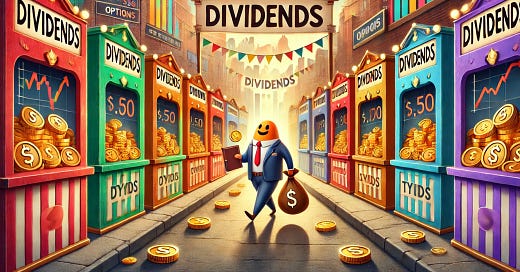It’s nice to get paid.
Distributions, dividends, and profit sharing all mean your investment made enough money that the business is willing to give something back to shareholders. There is no better project or use for the funds internally, and the owners want to take their cash out.
It’s easy to get distracted by line charts that go up and to the right. While META or NVDA technically pay dividends, that’s not why most investors hold the stock. Bitcoin doesn’t even produce anything and plenty of money gets poured in there in the hopes of capital gains.
A dividend payout is never going to knock your socks off. Yield in the double digits has my spidey sense tingling. A first guess is that price action has been highly unfavorable recently, and the second is this is a return of capital trick/hack played by options ETFs.
It’s a wild world out there, and a business that is able to maintain their competitive position all while sending money out the door in excess of the equity risk premium will get a lot of demand, and thus drive the yield back to “fair” value.
There is a whole philosophy of investing around “dividend champions” that focuses the lens on companies that have continually paid and increased their distributions. Household names like Pepsico and Johnson &Johnson fit the bill because they have relatively stable demand and can deliver predictable streams of cash.
Equities go up and down. Capital gains are great and potentially significant, but they always come with more volatility than you expect. And different tax consequences. Overall returns from stock ownership come from both dimensions.
Options on equities are tools to trade the outcomes of the underlying price. Their value does take into account dividends for forward value, but they’re not paid directly. An overlay will shift your outcomes in price space, but you can also use derivatives to shift your concentrations in dividend space.
Today in Fifty Ways to Trade an Option, we’ll look at how dividend futures can adjust your portfolio's balance between equity and dividend returns.
Keep reading with a 7-day free trial
Subscribe to The Till to keep reading this post and get 7 days of free access to the full post archives.




